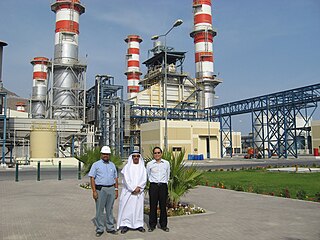
TotalEnergies SE is a European multinational integrated energy and petroleum company founded in 1924 and one of the seven supermajor oil companies. Its businesses cover the entire oil and gas chain, from crude oil and natural gas exploration and production to power generation, transportation, refining, petroleum product marketing, and international crude oil and product trading. TotalEnergies is also a large-scale chemicals manufacturer.

The Kintigh Generating Station, also known as Somerset Operating Co. LLC of the Upstate New York Power Producers was a 675-megawatt coal-fired power plant located in Somerset, New York, United States. The plant was owned by AES Corporation until bankruptcy. Its unit was launched into service in 1984. Coal is provided to the plant via the Somerset Railroad. The waste heat is dumped into Lake Ontario, resulting in a warm-water plume visible on satellite images. The plant's 625-foot smoke stack can be seen across Lake Ontario from the shores of Toronto, Pickering, Oshawa, and Ajax, Ontario. It can also be seen from points along the Niagara Escarpment, including Lockport, NY, approximately 20 miles south. Power from the plant is transferred by dual 345kV power lines on wood pylons, which run south from the plant through rural agricultural land. In Royalton, NY they split at their physical junction with the dual circuit 345-kV Niagara-to-Edic transmission line, owned by the New York Power Authority, one circuit heads west to a substation at Niagara Falls, the other heads east to Station 80 south of Rochester. This bulk electric transmission constraint, created by the Somerset plant tie-in and forcing wheeling through 230kV and 345kV transmission lines to the Homer City Coal Plant east of Pittsburgh, PA, and returning to NY at the Watercurry substation outside Elmira, will be resolved through the Empire State Line proposal approved by NY Independent System Operator (NYISO).

Fortum Oyj is a Finnish state-owned energy company located in Espoo, Finland. It mainly focuses on the Nordic region. Fortum operates power plants, including co-generation plants, and generates and sells electricity and heat. The company also sells waste services such as recycling, reutilisation, final disposal solutions and soil remediation and environmental constructions services, and other energy-related services and products e.g. consultancy services for power plants and electric vehicle charging. Fortum is listed on the NASDAQ OMX Helsinki stock exchange.
YTL Corporation Berhad is a Malaysian infrastructure conglomerate, founded in 1955 by Yeoh Tiong Lay, after whom the group is named. YTL Corporation Berhad is an integrated infrastructure developer with extensive operations in countries including Malaysia, Singapore, the United Kingdom, Australia, France, Indonesia, Japan, Jordan, Myanmar, the Netherlands, Thailand and Vietnam. The company has grown from a small construction firm into a global infrastructure company generating over RM18 billion in revenues with over 70 percent coming from overseas.
Doosan Group is a South Korean multinational conglomerate corporation. In 2009, the corporation was placed in the Fortune Global 500 index. It is the parent company of Bobcat and Škoda Power. Doosan Group is the oldest running company in South Korea and is ranked as one of the world's top 10 largest heavy equipment manufacturers in 2018.

Ballylumford power station is a natural-gas-fired power station in County Antrim, Northern Ireland, UK. With its main plant generating 600 megawatts of electricity, it is Northern Ireland's largest power station and provides half its power. Overall the station produces 600MW. The plant is located at the tip of the Islandmagee peninsula, which separates Larne Lough from the Irish Sea. The lough is a Site of Special Scientific Interest. The 3 chimneys of the power station are 126 metres tall. East of the station is the static inverter plant of HVDC Moyle, a power cable connecting the system to Great Britain.

Lopez Holdings Corporation is a Filipino conglomerate founded by the brothers Eugenio Lopez, Sr. and Fernando Lopez, Sr. It has substantial holdings in the public service and utilities sector in the Philippines and serves as the Lopez family's publicly listed holding company for investments in major development sectors such as broadcasting and cable; telecommunications; power generation and distribution; manufacturing; and property development. It added to its portfolio investments in other basic service sectors but has also since sold its interest in banking, toll roads, information technology, and health care delivery.

Drax Group PLC is a power generation business. The principal downstream enterprises are based in the UK and include Drax Power Limited, which runs the biomass and coal fuelled Drax power station, near Selby in North Yorkshire. The Group also runs an international biomass supply chain business. The company is listed on the London Stock Exchange and is a constituent of the FTSE 250 Index.
Korea Electric Power Corporation, better known as KEPCO or Hanjeon, is the largest electric utility in South Korea, responsible for the generation, transmission and distribution of electricity and the development of electric power projects including those in nuclear power, wind power and coal. KEPCO, through its subsidiaries, is responsible for 93% of Korea's electricity generation as of 2011. The South Korean government owns a 51.11% share of KEPCO. Together with its affiliates and subsidiaries, KEPCO has an installed capacity of 65,383 MW. On the 2011 Fortune Global 500 ranking of the world's largest companies, KEPCO was ranked 271. KEPCO is a member of the World Energy Council, the World Nuclear Association and the World Association of Nuclear Operators. As of August 2011, KEPCO possesses an A+ credit rating with Fitch Ratings, while Moody's has assigned KEPCO an A1 stable rating.
Al Qatrana power plant is a natural gas-fired power plant in Al Qatrana, 100 kilometres (62 mi) south of Amman, Jordan. The generating capacity of the power plant is 373 MW. Natural gas to the plant is supplied through the Arab Gas Pipeline..
Attarat Power Plant is an oil shale-fueled power plant under construction in the Attarat Um Ghudran area, 50 kilometres (31 mi) east of Al Qatranah in Jordan. The project is developed by the Attarat Power Company (APCO), a partnership between YTL Power International (45%), Guangdong Energy Group Co., Ltd. (45%) and Eesti Energia (10%). It is the first oil shale power plant in Jordan and the largest private sector project in Jordan to date.

Fujairah F1 Independent Water and Power Plant or Fujairah F1 IWPP is an independent water and power plant (IWPP) at Qidfa', Fujairah in the United Arab Emirates. It is located next to the Fujairah F2 IWPP. It is 5 kilometres (3.1 mi) south of Khor Fakkan and 20 kilometres (12 mi) north of the city of Fujairah. When constructed, the Fujairah plant was the first hybrid plant in the Middle East, and the largest desalination hybrid plant in the world.

Oil shale in Jordan represents a significant resource. Oil shale deposits in Jordan underlie more than 60% of Jordanian territory. The total resources amounts to 31 billion tonnes of oil shale.
Water supply and sanitation in Jordan is characterized by severe water scarcity, which has been exacerbated by forced immigration as a result of the 1948 Arab–Israeli War, the Six-Day War in 1967, the Gulf War of 1990, the Iraq War of 2003 and the Syrian Civil War since 2011. Jordan is considered one of the ten most water scarce countries in the world. High population growth, the depletion of groundwater reserves and the impacts of climate change are likely to aggravate the situation in the future.

Israel–Jordan relations are the diplomatic, economic and cultural relations between Israel and Jordan. The two countries share a land border, with three border crossings: Yitzhak Rabin/Wadi Araba Crossing, Jordan River Crossing and the Allenby/King Hussein Bridge Crossing, that connects the West Bank with Jordan. The relationship between the two countries is regulated by the Israel–Jordan peace treaty in 1994, which formally ended the state of war that had existed between the two countries since the establishment of the State of Israel in 1948, and also established diplomatic relations, besides other matters. Relations between the countries get strained from time to time, usually over tensions at the Al-Aqsa mosque. On 8 October 2020, Israel and Jordan reached an agreement to allow flights to cross over both countries’ airspace.
In December 2016, the Jordan Atomic Energy Commission (JAEC), in cooperation with a consortium headed by the Korean Atomic Energy Research Institute, inaugurated the 5 MW Jordan Research and Training Reactor. The facility is the first nuclear reactor in the country. It will provide radioactive isotopes for medical usage in Jordan, and will provide training for students at the University to produce a skilled workforce for the country's planned commercial nuclear reactors.
Ras Girtas Power Company is a power generation and water desalination plant located in Ras Laffan Industrial City, Qatar. It has installed capacity of 2,730 MW, which include eight gas turbines and four steam turbines by Mitsubishi Heavy Industries. The first stone of the plant was officially laid on 4 May 2009. The plant was commissioned on 31 May 2011 in the presence of the emir, Sheikh Hamad bin Khalifa Al-Thani, and it cost US3.9 billion. Once fully operational, the plant will produce 286,000 cubic metres per day (10,100,000 cu ft/d) of desalinated water. It uses ten multi-effect distillation/thermal vapour compression units built by Sidem.

Energy in Jordan describes energy and electricity production, consumption and import in Jordan. Jordan is among the highest in the world in dependency on foreign energy sources, with 96% of the country's energy needs coming from imported oil and natural gas from neighboring Middle Eastern countries. This complete reliance on foreign oil imports consumes a significant amount of Jordan's GDP. This led the country to plan investments of $15 billion in renewable and nuclear energy. To further address these problems, the National Energy Strategy for 2007-2020 was created which projects to boost reliance on domestic energy sources from 4 per cent to 40 per cent by the end of the decade.
Science and technology is Jordan's fastest-growing economic sector. This growth is occurring across multiple industries, including information and communications technology (ICT), solar and wind energy and nuclear technology.

Independent Power Corporation PLC (IPC) is a low carbon independent power producer (IPP) based in Millbank Tower.










